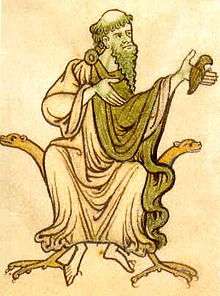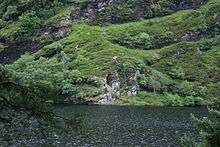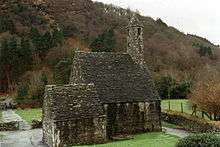Kevin of Glendalough
| Saint Kevin of Glendalough | |
|---|---|
 | |
| Born |
498 Ireland |
| Died | 3 June 618 |
| Venerated in |
Roman Catholic Church Eastern Orthodox Church Anglican Communion |
| Canonized | 1903 (cultus confirmed) |
| Feast | 3 June |
| Attributes | blackbird |
| Patronage | blackbirds, Archdiocese of Dublin, Glendalough, Kilnamanagh |
Saint Cóemgen (Irish: Caoimhín; Latin: Coemgenus[1]), popularly Anglicized to Kevin (498 – 3 June 618) is an Irish saint who was known as the founder and first abbot of Glendalough in County Wicklow, Ireland. His feast day in the Roman Catholic and Eastern Orthodox Churches is 3 June.[2]
Early life
His life is not well documented, as no contemporaneous material survives. His Latin vita (life) maintains that as with St. Columba, Kevin's family were of the nobility — he was the son of Coemlog and Coemell of Leinster. He was born in 498 at the Fort of the White Fountain.[3] He was given the Irish name Coemgen, which means "fair-begotten",[4] and was baptized by Cronan of Roscrea.
The Acta Sanctorum, which is based on an ancient manuscript, contains a number of legends. The author of a commentary on this manuscript, Fr. Francis Baert, S.J., explains "that although many of the legends given to this work are of doubtful veracity; it was decided to let them stand in favour of the antiquity of the document which is placed as having been written during or before the 12th century". St Kevin’s birth and early years figure prominently in traditional legends. In his infancy a mysterious white cow is said to have come to his parents' house every morning and evening and supplied the milk for the baby.[5] From the age of seven, he was educated by Saint Petroc of Cornwall, who had come to Leinster about 492, and lived with the monks until he was 12.
Glendalough
Glendalough, or the Glen of two Lakes, is one of the most important sites of monastic ruins in Ireland. Before the arrival of St. Kevin this glen would have been desolate and remote, and would have been ideal for a secluded retreat.[6]
Hermitage

Kevin was ordained by Bishop Lugidus and, following his ordination, he moved on to Glendalough in order to avoid the company of his followers. He lived as a hermit in a cave, a Bronze Age tomb now known as St. Kevin's Bed, to which he was reportedly led by an angel.[3]
St. Kevin’s Bed can best be described as a man-made cave cut in the rock face very close to the edge of the mountain. It overlooks the upper lake from a height of about 30 feet (10 metres). The approach to the cave is very difficult, with access to it through a rectangular space and a short passageway 3 ft. (1 metre) high and 2½ ft. wide. The inner or main part of the cave is just 4 ft. wide (1.5 metres) and less than 3 ft.(1 metre) high. It is reasonable to assume that the cave could only have been used as a sleeping place, and would have been impossible for an adult to stand upright in, so it is quite likely that St Kevin only used it as his bed, or a place for pious prayer or meditation. Dr. Leask expresses the opinion that this cave was constructed long before Kevin’s time and it was probably the first and oldest piece of work to be undertaken by man in the glen.
There is a legend which claims that St Laurence O’Toole used the "bed" as he frequently made penitential visits to Glendalough, especially during the season of Lent. Michael Dwyer, the famous Wicklow rebel, is reputed to have taken shelter in the "bed" while he was on the run from British soldiers. The story goes that he escaped capture one morning by diving into the lake and swimming to the opposite side. Today, it is highly dangerous to try to approach the "bed" from the side of Lugduff mountain. Visitors, in the interests of their own safety, should be content with a distant view of it from one of the boats which operate during the tourist season.[7]
Monastery

Kevin lived the life of a hermit there with an extraordinary closeness to nature. His companions were the animals and birds all around him. He lived as a hermit for seven years wearing only animal skins, sleeping on stones and eating very sparingly.[8] He went barefoot, and spent his time in prayer. Disciples were soon attracted to Kevin and a further settlement enclosed by a wall, called Kevin's Cell, was established nearer the lakeshore. By 540 Saint Kevin's fame as a teacher and holy man had spread far and wide. Many people came to seek his help and guidance. In time Glendalough grew into a renowned seminary of saints and scholars and the parent of several other monasteries.[8]
In 544 Kevin went to the Hill of Uisneach in County Westmeath to visit the holy abbots, Sts. Columba, Comgall and Cannich. He then proceeded to Clonmacnoise, where St. Cieran had died three days before. Having firmly established his community, he retired into solitude for four years, and only returned to Glendalough at the earnest entreaty of his monks.[4] Until his death around 618 Kevin presided over his monastery in Glendalough, living his life by fasting, praying and teaching. St Kevin is one of the patron saints of the diocese of Dublin.[8]
He belonged to the second order of Irish saints.[4] Eventually, Glendalough, with its seven churches, became one of the chief pilgrimage destinations in Ireland.

In culture
Kevin is remembered in popular culture as an ascetic. This is commemorated in a folk song about him which describes a legend claiming that he drowned a woman who attempted to seduce him. This was recorded and made popular by the Dubliners. The opening verse is as follows: "In Glendalogh there lived an auld saint, renowned for his learning and piety, his manners were curious and quaint, and he looked upon girls with disparity."
The independent film-maker Kevin Smith refers irreverently to his namesake 'Saint Kevin' and the key events of his life in the introduction to Sold Out: A Threevening with Kevin Smith, his 2008 live Q & A show.
One of the most widely known poems of the Nobel prizewinner Seamus Heaney, 'St Kevin and the Blackbird', relates the story of Kevin holding out his hand with trance-like stillness while a blackbird builds a nest in it, lays eggs, the eggs hatch and the chicks fledge.[9]
A major series of paintings by the Welsh artist Clive Hicks-Jenkins around 2009 depicted the story of Kevin and the blackbird, by way of Heaney's poem, with symbolism identified by Marly Youmans: 'The saint's arm is held outward like half of a crucifixion, reaching towards infinity, but on the open palm is one of the great works of time: a nest with three eggs.'[10]
References
- ↑ "Saint Kevin". Encyclopædia Britannica.
- ↑ "Kevin". Patron Saints Index. Retrieved 5 December 2007.
- 1 2 Haggerty, Bridget, "St. Kevin - founder of Glendalough", Irish Culture and Customs
- 1 2 3 Edmonds, Columba. "St. Kevin (Coemgen)." The Catholic Encyclopedia. Vol. 4. New York: Robert Appleton Company, 1908. 8 Feb. 2013
- ↑ "Legends of St. Kevin", Glendalough Monastice History
- ↑ "Introduction to Glendalough", County Wicklow
- ↑ "Kevin's Bed", County Wicklow
- 1 2 3 "Kevin of Glendalough", Dublin Diocese Jubilee
- ↑ Heaney, Seamus, The Spirit Level (London: Faber and Faber, 1996), pp20-1.
- ↑ Marly Youmans, 'Fire in the Labyrinth' in Simon Callow, Andrew Green, Rex Harley, Clive Hicks-Jenkins, Kathe Koja, Anita Mills, Montserrat Prat, Jacqueline Thalmann, Damian Walford Davies and Marly Youmans, Clive Hicks-Jenkins (2011: Lund Humphries) ISBN 978-1-84822-082-9, pp. 99-123
Further reading
Primary sources
- Latin vita of St Kevin, ed. Charles Plummer, "Vita Sancti Coemgeni (Life of St. Kevin)." In Vitae Sanctorum Hiberniae. Vol. 1. Oxford: Clarendon Press, 1910. 234–57.
- Irish vita of St Kevin, ed. Charles Plummer, "Betha Caimgin (Life of St. Kevin)." In Bethada Nóem nÉrenn (Live of Irish Saints). Oxford: Clarendon Press, 1922. Vol. 1: 125–67 and vol. 2: 121–61. Edition available from CELT.
- Gerald of Wales, Topographia Hibernica.
Secondary sources
- Barrow, Lennox. Glendalough and Saint Kevin. Dundalk: Dundalgan Press, 1972.
- MacShamhrain, A.S. "The 'unity' of Cóemgen and Ciarán. A convent between Glendalough and Clonmacnoise in the tenth to eleventh centuries." In Wicklow: history and society: interdisciplinary essays on the history of an Irish county, ed. by Ken Hannigan and William Nolan. Dublin: Geography Publications, 1994. 139-50.